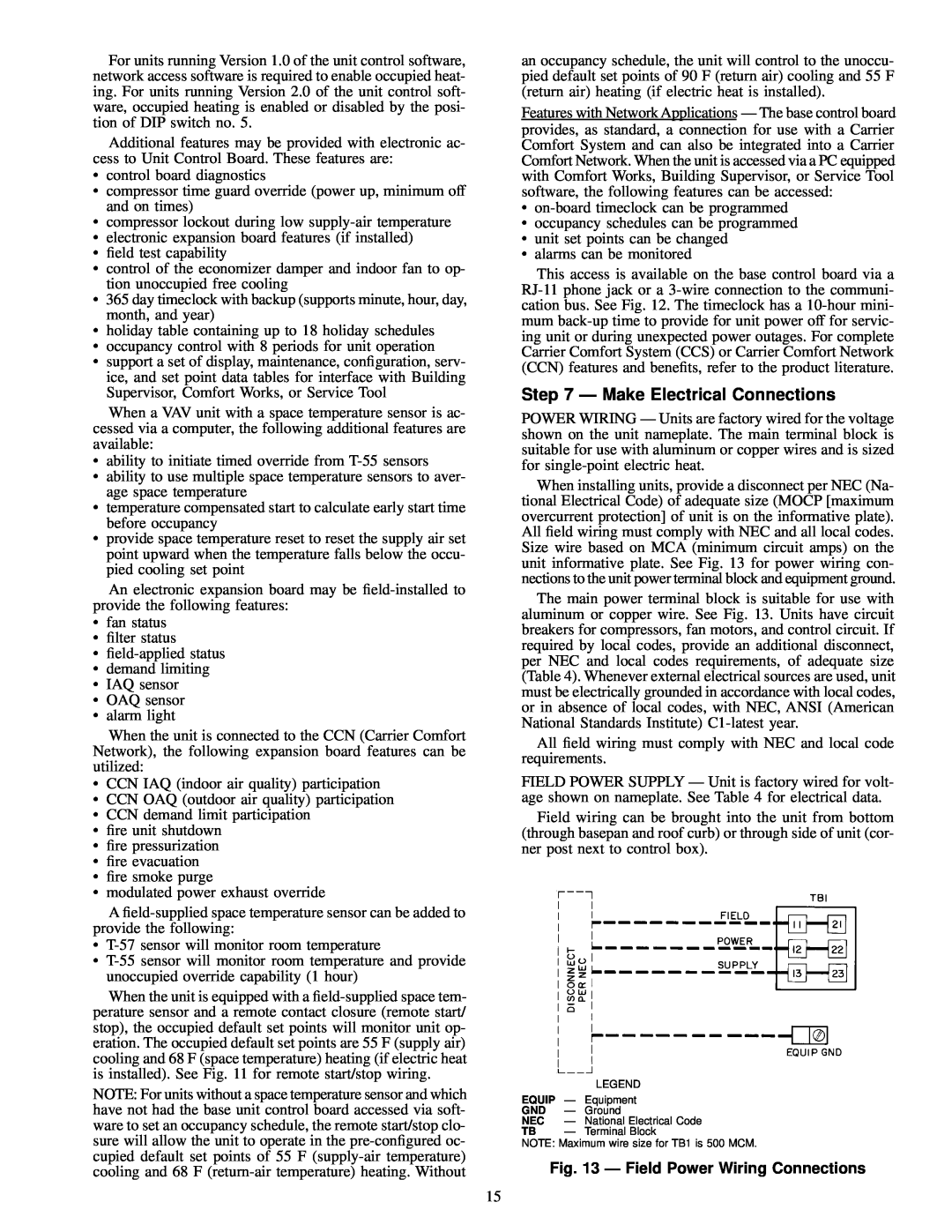
For units running Version 1.0 of the unit control software, network access software is required to enable occupied heat- ing. For units running Version 2.0 of the unit control soft- ware, occupied heating is enabled or disabled by the posi- tion of DIP switch no. 5.
Additional features may be provided with electronic ac- cess to Unit Control Board. These features are:
·control board diagnostics
·compressor time guard override (power up, minimum off and on times)
·compressor lockout during low
·electronic expansion board features (if installed)
·®eld test capability
·control of the economizer damper and indoor fan to op- tion unoccupied free cooling
·365 day timeclock with backup (supports minute, hour, day, month, and year)
·holiday table containing up to 18 holiday schedules
·occupancy control with 8 periods for unit operation
·support a set of display, maintenance, con®guration, serv- ice, and set point data tables for interface with Building Supervisor, Comfort Works, or Service Tool
When a VAV unit with a space temperature sensor is ac- cessed via a computer, the following additional features are available:
·ability to initiate timed override from
·ability to use multiple space temperature sensors to aver- age space temperature
·temperature compensated start to calculate early start time before occupancy
·provide space temperature reset to reset the supply air set point upward when the temperature falls below the occu- pied cooling set point
An electronic expansion board may be
·fan status
·®lter status
·
·demand limiting
·IAQ sensor
·OAQ sensor
·alarm light
When the unit is connected to the CCN (Carrier Comfort Network), the following expansion board features can be utilized:
·CCN IAQ (indoor air quality) participation
·CCN OAQ (outdoor air quality) participation
·CCN demand limit participation
·®re unit shutdown
·®re pressurization
·®re evacuation
·®re smoke purge
·modulated power exhaust override
A
·
·
When the unit is equipped with a
NOTE: For units without a space temperature sensor and which have not had the base unit control board accessed via soft- ware to set an occupancy schedule, the remote start/stop clo- sure will allow the unit to operate in the
an occupancy schedule, the unit will control to the unoccu- pied default set points of 90 F (return air) cooling and 55 F (return air) heating (if electric heat is installed).
Features with Network Applications Ð The base control board provides, as standard, a connection for use with a Carrier Comfort System and can also be integrated into a Carrier Comfort Network. When the unit is accessed via a PC equipped with Comfort Works, Building Supervisor, or Service Tool software, the following features can be accessed:
·
·occupancy schedules can be programmed
·unit set points can be changed
·alarms can be monitored
This access is available on the base control board via a
Step 7 Ð Make Electrical Connections
POWER WIRING Ð Units are factory wired for the voltage shown on the unit nameplate. The main terminal block is suitable for use with aluminum or copper wires and is sized for
When installing units, provide a disconnect per NEC (Na- tional Electrical Code) of adequate size (MOCP [maximum overcurrent protection] of unit is on the informative plate). All ®eld wiring must comply with NEC and all local codes. Size wire based on MCA (minimum circuit amps) on the unit informative plate. See Fig. 13 for power wiring con- nections to the unit power terminal block and equipment ground.
The main power terminal block is suitable for use with aluminum or copper wire. See Fig. 13. Units have circuit breakers for compressors, fan motors, and control circuit. If required by local codes, provide an additional disconnect, per NEC and local codes requirements, of adequate size (Table 4). Whenever external electrical sources are used, unit must be electrically grounded in accordance with local codes, or in absence of local codes, with NEC, ANSI (American National Standards Institute)
All ®eld wiring must comply with NEC and local code requirements.
FIELD POWER SUPPLY Ð Unit is factory wired for volt- age shown on nameplate. See Table 4 for electrical data.
Field wiring can be brought into the unit from bottom (through basepan and roof curb) or through side of unit (cor- ner post next to control box).
|
| LEGEND |
EQUIP | Ð | Equipment |
GND | Ð Ground | |
NEC | Ð | National Electrical Code |
TB | Ð | Terminal Block |
NOTE: Maximum wire size for TB1 is 500 MCM.
Fig. 13 Ð Field Power Wiring Connections
15
